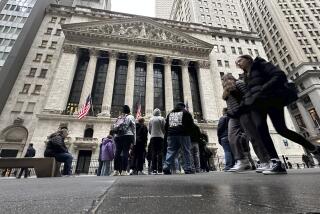The Road to Recovery : Survey Finds Some Industries Rolling Along but Others Are Stalled : FINANCIAL SERVICES
- Share via
Unlike people in most industries, executives in the securities business can pinpoint the precise moment their business drought came to an end:
The explosive stock market rally that began Jan. 17 after the U.S.-led coalition launched its attack on Iraq “brought people rushing back into the market with both feet,” said Thomas Quick, president of discount broker Quick & Reilly Inc.
The buying stampede led to a sharp turnaround in brokerage industry fortunes as the industry went from its worst loss in history in calendar year 1990 to one of its best quarters ever in early 1991, according to the Securities Industry Assn.
New York Stock Exchange volume surged to a daily average of 195 million shares during the period, 21.6% higher than the year-earlier period--and even topping the record daily average of 189.2 million in 1987. With interest rates falling, institutional corporate bond trading jumped 50% in the first quarter from the year-earlier period and the surge in public stock offerings also filled industry coffers.
Despite the surge in business, industry officials, chastened by the three-year slump, have been cautious about adding new staff. “Our head count is actually around 500 lower today than in January,” said Merrill Lynch Executive Vice President Jerome P. Kenney. “We’re trying to hold the line to better assess the extent of the recovery.”
Still, Quick & Reilly, emboldened by the surge in retail business, plans to open at least five new offices in the next few months--in Austin, Tex.; Las Vegas; Minneapolis, and Walnut Creek and Riverside, Calif.
More to Read
Inside the business of entertainment
The Wide Shot brings you news, analysis and insights on everything from streaming wars to production — and what it all means for the future.
You may occasionally receive promotional content from the Los Angeles Times.










